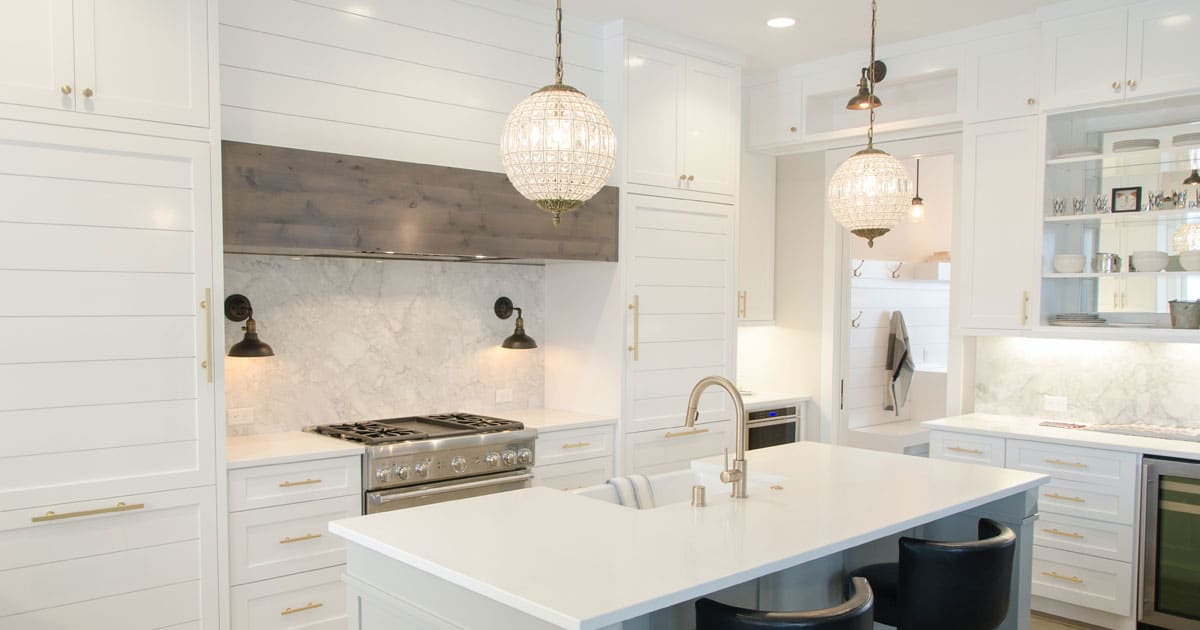Everyone wants their kitchen to be well-lit. After all, it’s where we prepare our meals. But sometimes, good intentions can result in bad lighting design. Here are seven common kitchen lighting mistakes to avoid, plus better ideas to follow. With a little planning, you can create a bright and welcoming space that is both functional and stylish. Let’s get started!

Harsh, fluorescent light – replace with softer, more natural light
Fluorescent lights in office spaces can cause headaches, exhaustion, and a decrease in productivity. Switching to softer lighting with higher-quality light bulbs that mimic natural light is the answer. Natural light cascading through windows makes it easier to concentrate; research suggests it can also make us feel more productive and healthy overall. While making this shift may initially be expensive, these costs are outweighed by improved productivity as well as a reduction of sick days employees possibly take due to eyestrain and exhaustion resulting from harsh fluorescent lighting. Investing in softer and more natural light will benefit everyone in space.
Not enough light – add additional lighting fixtures or increase the wattage of existing ones
If you find that there’s not enough light in your kitchen and need to increase the illumination, there are a few easy solutions. Adding a set of pendant lights to the room is a great way to instantly create more light and ambiance. You can also opt to increase the wattage of any existing kitchen lighting fixtures, such as recessed cans or track lighting, for an increased level of brightness. Kitchen lighting should be specific and tailored to your needs – having too little or too much is easily avoided with careful consideration when adding or increasing the wattage of your fixtures.
Too much light – use dimmers to adjust the amount of light in the room
Too much light in a room can be uncomfortable and distracting. Thankfully, an easy fix exists for this problem: use dimmers to adjust the amount of light! Dimmers give users control over the level of illumination in their home and enable them to set the perfect combination of mood and visibility. By providing more flexibility and energy efficiency than traditional wall switches, dimmers are perfect for lighting up any room—regardless of its size—to perfection. Whether you’re entertaining guests or just want to relax with a book or magazine, using dimmers will help you achieve your desired atmosphere easily.
One central fixture – add multiple lighting sources around the kitchen for better illumination
Adding multiple lighting sources to a kitchen space can provide much-needed atmospheric ambiance and illumination. Strategically placed lamps, kitchen pendant lights, and fixtures can brighten baked goods and dinner plating presentations while infusing the area with subtle color-changing LEDs or a classic candlelight vibe. Properly planning out the amount and type of fixtures required for your kitchen, depending on desired light levels and style, is crucial for getting the best illumination possible. In general, you should start from one central fixture and work your way outward to create a beautiful, inviting atmosphere in the heart of your home.
Lights that don’t match – Choose a cohesive style for all your kitchen lights
When people think of kitchen lights, there is often a temptation to choose different styles for each light depending on functionality and preference. However, using a cohesive style throughout the room will create a polished, finished look and give the impression of greater sophistication. Whether your style is modern, traditional, or even funky and eclectic, finding light fixtures that match can do wonders to unify the overall design of the kitchen. The result? A lovely interior to dine in with family and friends while also enjoying the timeless beauty of perfectly matched lighting.
Ignoring task lighting – install under-cabinet and over-sink lighting to make food preparation easier
Preparing food can be daunting and tiring; not having the right lighting can make it even harder. For those times when natural light is just not enough, installing task lighting in the kitchen can make a world of difference. Under-cabinet and over-sink lights are especially useful when creating meals, as they casts intensely focused light exactly where it’s needed most. These simple additions to kitchen décor offer a practical solution to reduce fatigue and frustrations in mundane meal preparation tasks. With plenty of styles to choose from, task lighting throughout the kitchen takes things up a notch and offers improvements like ambiance and convenience that can easily start improving your daily life today.
In conclusion, lighting should play an important role in the design of your kitchen. It adds function, mood, and style to a space that can often be overlooked. Harsh fluorescent lights should be replaced with softer, more natural lights to create a relaxing atmosphere. If there is not enough light, additional fixtures or increased wattage of existing ones should be considered. Too much light can also be uncomfortable; dimmers can be used as a solution. Opt for multiple lighting sources and make sure all your lighting is cohesive in style.
Finally, don’t forget about task lighting – under-cabinet and over-sink lighting are essential for making food preparation easier. Lighting can make or break your kitchen design so choose wisely!
